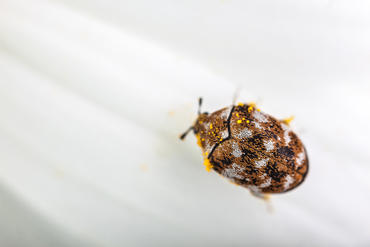 The damage left by carpet beetles can often be mistaken for the damage caused by moths – both are similar – but, when it comes to attempting to deal with the infestation yourself, many people buy the wrong products to treat the wrong pest!
The damage left by carpet beetles can often be mistaken for the damage caused by moths – both are similar – but, when it comes to attempting to deal with the infestation yourself, many people buy the wrong products to treat the wrong pest!
Carpet beetles, like moths, are a nuisance pest; they do not carry disease but cause untold damage to carpets and textiles with a high natural fibre content. Like moths, they eat and enjoy natural materials such as leather, wool, fur, silk and cotton.
Identifying a carpet beetle
Small and round, a carpet beetle is around the same size as a ladybird. Dark brown or black in colour, they also have mottled patches of white or yellow on them; fur beetles also have a single white spot on each wing.
Carpet beetle – the life cycle
- Early spring and summer – the female carpet beetle will choose materials and fabrics with high natural fibre content to lay her eggs; she can lay between 20 and 100 eggs. Once hatched, they are known as woolly bears as the larvae is hairy and brown! They avoid light and, if touched, roll up in to a ball to protect themselves.
- Summer – over the warmer months, the larvae chew their way through as much natural materials as they can before they pupate, becoming adults shortly after.
How to spot the signs of carpet beetles
There are many tell-tale signs but, as previously mentioned, it is common to mistake the damage as being of that left by moths and so a professional pest controller is the best person to be able to identify any infestation…
- Sightings – with carpet beetles, you tend to see them at some point, either as adult beetles or the woolly bears; adults are also attracted to daylight and can be found clustered together on the window sill of a property on a bright, sunny day
- Bird nests – if you have had an issue with birds nesting around your property, it may be that as a by-product of this problem, you have inherited carpet beetles within the home; it is a known fact that carpet beetles often enter a property through bird nests on or close to a building
- Damage – carpets and clothes can be left with large holes in them as a result of the carpet beetle larvae chomping their way through the natural fibres. Like the moth, a small % of the material only needs to be made form a natural fibre – a wool mix or cotton, for example – and the carpet beetle can cause expensive damage. Remember to check under the legs and feet of furniture items on a carpet; you may be surprised to discover a thread bare patch of carpet.
How do pest controllers deal with carpet beetle infestations?
- Identification – the first step is to identify the infestation as being one caused by carpet beetles and not another insect that causes similar damage.
- The source – treatment is only truly effective when the source of the carpet beetle infestation is identified too; hence you may find the pest controller removing bird nests from roofs and nearby trees before they treat the infestation inside
- Treatment – there are a variety of chemical treatments that can be applied to carpets, soft furnishings and materials, with certain parts of the room needing particular attention (corners, under skirting boards etc.). Larvae can ‘hide’ in these dark crevices and so need to be carefully treated to ensure that the infestation does not return.
- Cleaning – following treatment it is vital that the property undergoes a deep clean to remove all eggs, larvae and pupae BUT, this must not be done for several days AFTER treatment, to allow the insecticide to work; your pest controller will give you more details and advice.
Think you may have carpet beetles?
Check before you treat as you may be wasting money on the wrong chemical treatment! Call in a professional pest controller and get the right advice and the right treatment.
